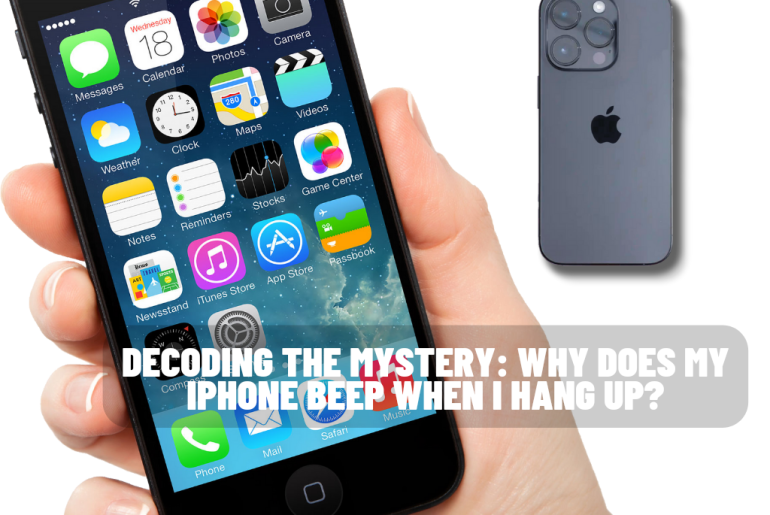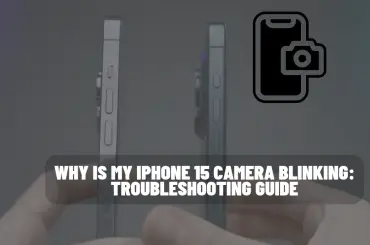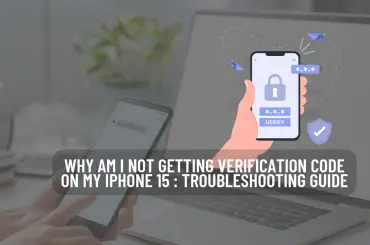Smartphones have become an integral part of our daily lives, seamlessly connecting us with others through calls, texts, and various applications. However, as technology advances, so do the occasional quirks and mysteries that users encounter. One perplexing issue that iPhone users, particularly those with the latest models like the iPhone 13 Pro, have reported is the loud beeping sound experienced after ending a phone call. This article aims to delve into this mystery, exploring the potential reasons behind the loud beep and providing insights into possible solutions.
The iPhone Beep Phenomenon: Why Does My iPhone Beep When I Hang Up?
Understanding the Beep
At the heart of the perplexing iPhone mystery lies a distinctive sound, one that users describe not as a subtle notification, but rather a loud, speaker-like beep that resounds immediately after ending a phone call. This peculiar auditory occurrence has become a point of concern for iPhone users, with reports indicating that the beep is not merely a post-call signal but an unsettling and, at times, uncomfortable experience. Users have likened its volume to that of the preceding conversation, raising questions about its origins and the potential harm it may inflict on their auditory senses.
This loud, post-call beep has emerged as more than just an inconspicuous soundbite; it’s a disruptive element that demands attention. Users have expressed their discomfort, emphasizing the intensity of the beep, which can be as loud as the conversation itself. The unexpected volume of this sound has led to concerns about potential hearing damage, prompting users to seek answers and solutions.
Common Scenarios Leading to the Beep: Unraveling Triggers
To unravel the mystery, it’s imperative to delve into the common scenarios during which users encounter the loud beep. Understanding when this sound occurs provides a critical context for identifying its triggers and potential sources. Regular phone calls, the cornerstone of mobile communication, are under scrutiny, with users questioning whether the beep is an inherent part of call termination or a glitch in the system.
Beyond routine calls, exploration extends to specific features such as FaceTime or voicemail, where users have reported the same auditory disturbance. By pinpointing these scenarios, the investigation aims to discern patterns and isolate the circumstances that consistently lead to the post-call beep. This meticulous examination of user experiences sheds light on the breadth of situations in which the beep manifests, contributing to a comprehensive understanding of the issue.
User Experiences: A Tapestry of Anomalies
User testimonials serve as a crucial component in decoding the loud beep phenomenon. These firsthand accounts provide a mosaic of experiences, as users from various iPhone models, spanning from the iPhone SE to the cutting-edge iPhone 13 Pro, share their encounters with the disruptive sound. The diversity of scenarios in which users face the loud beep underscores the widespread nature of the problem, transcending specific models or iOS versions.
The collective narrative paints a vivid picture of the issue’s impact, capturing moments when the loud beep disrupts the expected post-call silence. Whether it’s an iPhone SE user puzzled by the sudden volume surge or an iPhone 13 Pro owner grappling with discomfort, these user experiences form the foundation for understanding the scope of the problem and the urgency for a comprehensive solution.
Technical Insights Behind the Beeping Mechanism
As users grapple with the unsettling loud beep following iPhone calls, the quest for answers leads to a meticulous exploration of various facets, including the impact of operating system updates, hardware considerations, and the role of settings and customization.
Operating System Updates: Unraveling Software Ties
One plausible avenue for investigation is the correlation between the loud beep and specific iOS versions. Users have astutely pointed out this association, suggesting that changes in the operating system may be instrumental in the emergence of the disruptive sound. Analyzing the evolution of the beep across different iOS updates becomes pivotal in determining whether this auditory anomaly is, indeed, a software-related problem.
By tracing the trajectory of the loud beep through various iOS versions, we aim to discern patterns and pinpoint instances of change or implementation that may coincide with the onset of the issue. This examination of the software landscape provides valuable insights into the potential triggers behind the loud beep, paving the way for informed solutions.
Hardware Considerations
The role of iPhone models in the beeping phenomenon stands as another critical consideration. Does the issue predominantly afflict specific iPhone models, such as the iPhone 13 Pro, or is it a pervasive challenge spanning various generations? Understanding whether hardware intricacies contribute to the loud beep is essential for a comprehensive diagnosis.
Investigating potential hardware-related issues becomes paramount. Issues such as speaker malfunctions or other components influencing call termination must be scrutinized. This scrutiny aims to establish whether the loud beep is a result of systemic hardware challenges, directing efforts towards targeted resolutions.
Settings and Customization
Users often navigate through the labyrinth of settings and customization options to tailor their iPhone experience. The examination of user-configurable settings related to call termination becomes a vital aspect of the investigation. Insights into whether the loud beep is influenced by user preferences or if it is a default behavior that requires adjustment lie within these settings.
Reviewing the relevant settings sheds light on potential triggers or configurations that may inadvertently lead to the loud beep. This analysis seeks to differentiate between intentional user choices and unexpected defaults, facilitating a nuanced understanding of the user experience.
How to Stop the Beep
DIY Fixes for the Loud Beep Conundrum
In the relentless pursuit of a resolution to the disruptive loud beep that echoes through iPhones after calls, users have embarked on a journey of do-it-yourself (DIY) fixes. These user-driven initiatives encompass a spectrum of actions, from tweaking settings to seeking solace in online communities, providing valuable insights for those grappling with the same auditory enigma.
User-Initiated Solutions
The ingenuity of iPhone users comes to the forefront as they experiment with DIY fixes in an attempt to silence the unexpected post-call beep. Adjusting settings emerges as a common strategy, with users exploring various configurations related to call termination. Whether it involves tinkering with volume controls or delving into call-specific settings, users are on a mission to regain control over their iPhone’s auditory landscape.
Restarting the phone, a classic troubleshooting technique, is another avenue users traverse in the hope of bidding farewell to the disruptive beep. The rationale behind this action extends beyond a mere reboot; users speculate that a fresh start might reset any potential software glitches contributing to the issue.
Understanding these DIY fixes is crucial for users seeking immediate relief from the loud beep. By unraveling the methods users employ to address the issue independently, a collective knowledge base emerges, offering a repertoire of potential solutions for those navigating the auditory labyrinth of their iPhones.
Feedback and Support Communities: Harnessing Collective Wisdom
The digital realm becomes a refuge for users seeking solidarity and solutions. Online forums and communities dedicated to iPhone troubleshooting serve as virtual town halls where users share their experiences and exchange advice. Examining these discussions unveils a tapestry of collective frustration and inventive strategies users employ to cope with the loud beep.
From anecdotal success stories to cautionary tales of failed attempts, these online spaces provide a wealth of insights into the diverse approaches users undertake. They also underscore the importance of community-driven initiatives in addressing such issues. Users find solace in the shared struggles of their peers and, in turn, contribute to a pool of knowledge that extends beyond individual experiences.
When to Contact Apple Support: Navigating Professional Assistance
While DIY fixes form an integral part of the user-driven quest for a solution, there comes a point when professional assistance becomes imperative. Determining when to contact Apple Support is a crucial consideration for users dealing with the persistent loud beep. Apple’s support channels are equipped to provide expert guidance and tailored solutions.
Understanding the circumstances under which users should reach out to Apple Support ensures that they receive timely and effective assistance. Whether it’s discerning a potential hardware issue or navigating complex software intricacies, users can leverage Apple’s expertise to address the loud beep comprehensively.
What to Expect In Future
In the labyrinth of iPhone mysteries surrounding the disruptive loud beep, an exploration of Apple’s response and track record becomes pivotal for users seeking a resolution. Delving into the company’s historical approach to similar issues offers insights into potential timelines for fixes and the nature of interventions.
Apple’s Track Record: Lessons from the Past
To comprehend how Apple might address the current loud beep predicament, it’s essential to scrutinize the company’s response to similar issues in the past. Have there been instances where Apple tackled problems related to unexpected sounds or disruptions post-call? Understanding the nature of fixes implemented in the past can provide a roadmap for predicting potential strategies for the current issue.
By dissecting Apple’s historical responses, we gain a nuanced understanding of the company’s commitment to resolving user-reported problems. Whether it involves software updates, patches, or specific troubleshooting steps, a retrospective analysis informs users about the possible trajectory of Apple’s intervention in the ongoing loud beep saga.
User Feedback and Impact: The Pulse of the Community
The heartbeat of any resolution lies in the ongoing feedback loop between users and Apple. Monitoring user responses to system updates is a crucial facet of this dynamic. The article will explore how the iPhone community reacts to updates rolled out by Apple and whether these updates effectively address the loud beep issue.
User-driven initiatives, such as those discussed in online forums and communities, will also be under scrutiny. This collaborative effort among users to address the loud beep highlights the collective determination to find a solution. Examining the impact of these initiatives on the broader user community sheds light on the resilience and innovation within the iPhone user base.
As users contribute their experiences, feedback, and potential solutions, a comprehensive understanding of the issue’s impact emerges. This collaborative feedback loop not only informs Apple about the persistence of the loud beep issue but also empowers users by fostering a sense of shared responsibility for finding a resolution.
What forums say
The issue was first reported by a user of the iPhone 13 Pro, highlighting the sudden and intense nature of the loud beep. The absence of relevant settings for beep control adds to the frustration, prompting the user to question whether an update is needed to correct the issue.
Community Responses
The community response reveals that the problem extends beyond a single user and model. iPhone SE and iPhone 11 users report similar experiences, suggesting a systemic issue. Reports of the loud beep surfacing after the iOS 16.5 update become a recurring theme in the responses.
Examining the timeline of reports provides context to the issue. Reports of user complaints date back to iOS 15 updates, with a recent surge in reports after the iOS 16.5 update. This timeline helps establish the duration and persistence of the problem.
Troubleshooting and Solutions
Users have attempted various fixes, including rebooting their phones, with limited success. The frustration expressed by the community underscores the urgency for a comprehensive solution.
Inquiries and responses from Apple provide a glimpse into the company’s awareness of the issue. While users acknowledge the inconvenience, the lack of a definitive solution leaves the community in anticipation of a future update.
Temporary Solutions
Recommendations from users, coupled with Apple’s acknowledgment of the inconvenience, form a basis for temporary solutions. The article explores how users are coping with the issue until a permanent fix is introduced.
You May Also Like:
- Why does my iPhone 15 keep restarting : Troubleshooting Guide
- How To Make iPhone 15 Screen Turn Off And Understanding Always-On Display On iPhone 15 Pro
- Will iOS 16 slow down my iPhone 11 : The Pros and Cons of Updating iPhone 11 to iOS 16
- Why is my iPhone camera flickering : Troubleshooting iPhone Camera Flickering
- The Best iPhone for You in 2022: Which of Apple’s Phones Is It?
Conclusion
The loud beep phenomenon after ending iPhone calls is a complex issue that requires a multifaceted approach for resolution. By understanding the nature of the beep, exploring technical aspects, providing troubleshooting guidance, and anticipating future developments, this article aims to equip users with the knowledge needed to navigate and, ultimately, overcome this perplexing iPhone mystery. As the Apple community awaits a definitive solution, users are encouraged to share their experiences, contribute to support communities, and stay informed about updates that may address the loud beep issue plaguing their iPhones.



